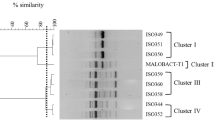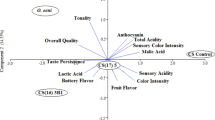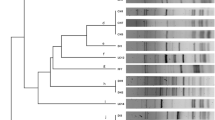Abstract
Oenococcus oeni (O. oeni) strains are critically important for winemaking. They bring microbial stabilization, de-acidification and sensory improvement through malolactic fermentation (MLF) to almost all red wines and some white wines. In this study, 23 strains of O. oeni isolated from China were evaluated for use as MLF starter cultures. Strains were characterized and screened in wine-like media with increasing selective pressure, such as low pH and high ethanol concentration. Their abilities to conduct MLF were affected significantly by ethanol concentration and pH. Eight strains were selected and subsequently evaluated by detecting the enzyme-encoding genes involved in biogenic amines synthesis and wine aroma modification. Seven well-performing strains were further assessed in newly alcohol-fermented Cabernet Sauvignon wine. The results show that strains O. oeni CS-4b and O. oeni ME-5b exhibited better performance than the commercial starter O. oeni 31MBR in wine. Therefore, they were selected as potential MLF starters suitable for wine with high ethanol concentration and low pH.




Similar content being viewed by others
References
Ancín-Azpilicueta C, González-Marco A, Jiménez-Moreno N (2008) Current knowledge about the presence of amines in wine. Crit Rev Food Sci Nutr 48:257–275
Baffi MA, Tobal T, Lago JH, Boscolo M, Gomes E, Da-Silva R (2013) Wine aroma improvement using a β-glucosidase preparation from Aureobasidium pullulans. Appl Biochem Biotechnol 169:493–501
Bartowsky EJ, Borneman AR (2011) Genomic variations of Oenococcus oeni strains and the potential to impact on malolactic fermentation and aroma compounds in wine. Appl Microbiol Biotechnol 92:441–447
Bauer R, Dicks LMT (2004) Control of malolactic fermentation in wine. A review. South Afr J Enol Vitic 25:74–88
Bordas M, Araque I, Alegret JO et al (2013) Isolation, selection, and characterization of highly ethanol-tolerant strains of Oenococcus oeni from south Catalonia. Int Microbiol 16:113–123
Cabrita MJ, Torres M, Palma V et al (2008) Impact of malolactic fermentation on low molecular weight phenolic compounds. Talanta 74:1281–1286
Capozzi V, Russo P, Beneduce L et al (2010) Technological properties of Oenococcus oeni strains isolated from typical southern Italian wines. Lett Appl Microbiol 50:327–334
Cavin JF, Andioc V, Etievant PX, Divies C (1993) Ability of wine lactic acid bacteria to metabolize phenol carboxylic acids. Am J Enol Vitic 44:76–80
Coton M, Romano A, Spano G, Ziegler K, Vetrana C, Desmarais C, Lonvaud-Funel A, Lucas P, Coton E (2010) Occurrence of biogenic amine-forming lactic acid bacteria in wine and cider. Food Microbiol 27:1078–1085
Coucheney F, Desroche N, Bou M et al (2005) A new approach for selection of Oenococcus oeni strains in order to produce malolactic starters. Int J Food Microbiol 105:463–470
De Revel G, Martin N, Pripis-Nicolau L et al (1999) Contribution to the knowledge of malolactic fermentation influence on wine aroma. J Agric Food Chem 47:4003–4008
Del Mónaco SM, Barda NB, Rubio NC, Caballero AC (2014) Selection and characterization of a Patagonian Pichia kudriavzevii for wine deacidification. J Appl Microbiol 117:451–464
Gambaro A, Boido E, Zlotejablko A, et al. (2001) Effect of malolactic fermentation on the aroma properties of Tannat wine. Aust J Grape Wine Res 7:27–32
García-Ruiz A, Bartolomé B, Cueva C, Martín-Alvarez PJ, Moreno-Arribas MV (2009) Inactivation of oenological lactic acid bacteria (Lactobacillus hilgardii and Pediococcus pentosaceus) by wine phenolic compounds. J Appl Microbiol 107:1042–1053
Gockowiak H, Henschke PA (2003) Interaction of pH, ethanol concentration and wine matrix on induction of malolactic fermentation with commercial “direct inoculation” starter cultures. Aust J Grape Wine Res 9:200–209
Guerrini S, Mangani S, Granchi L, Vincenzini M (2002) Biogenic amine production by Oenococcus oeni. Curr Microbiol 44:374–378
Lerm E, Engelbrecht L, du Toit M (2011) Selection and characterisation of Oenococcus oeni and Lactobacillus plantarum South African wine isolates for use as malolactic fermentation starter cultures. South Afr J Enol Vitic 32:280–295
Li N, Duan J, Gao D et al (2014) Mutation and selection of Oenococcus oeni for controlling wine malolactic fermentation. Eur Food Res Technol 240:93–100
Liu SQ (2002) Malolactic fermentation in wine—beyond deacidification. J Appl Microbiol 92:589–601
Liu S, Yu D (2010) 16S rDNA PCR-RFLP analysis of different Oenococcus oeni strains (In Chinese). Acta Agric Boreali-Occiden Sin 19:181–186.
Lonvaud-Funel A (1999) Lactic acid bacteria in the quality improvement and depreciation of wine. Antonie Van Leeuwenhoek 76:317–331
Maicas S, Gil JV, Pardo I, Ferrer S (1999) Improvement of volatile composition of wines by controlled addition of malolactic bacteria. Food Res Int 32:491–496
Marcobal Á, de las Rivas B, Moreno-Arribas M, Muñoz A (2005) Multiplex PCR method for the simultaneous detection of histamine-, tyramine-, and putrescine-producing lactic acid bacteria in foods. J Food Prot 68:874–878
Matthews A, Grbin PR, Jiranek V (2006) A survey of lactic acid bacteria for enzymes of interest to oenology. Aust J Grape Wine Res 12:235–244
Michlmayr H, Schümann C, Wurbs P et al (2010) A β-glucosidase from Oenococcus oeni ATCC BAA-1163 with potential for aroma release in wine: cloning and expression in E. coli. World J Microbiol Biotechnol 26:1281–1289
Moreno-Arribas V, Torlois S, Joyeux A et al (2000) Isolation, properties and behaviour of tyramine-producing lactic acid bacteria from wine. J Appl Microbiol 88:584–593
Mtshali PS, Divol B, Van Rensburg P, Du Toit M (2010) Genetic screening of wine-related enzymes in Lactobacillus species isolated from South African wines. J Appl Microbiol 108:1389–1397
Osborne JP, Edwards CG (2006) Inhibition of malolactic fermentation by Saccharomyces during alcoholic fermentation under low- and high-nitrogen conditions: a study in synthetic media. Aust J Grape Wine Res 12:69–78
Pérez-Martín F, Seseña S, Izquierdo PM, Palop ML (2013) Esterase activity of lactic acid bacteria isolated from malolactic fermentation of red wines. Int J Food Microbiol 163:153–158
Pérez-Martín F, Izquierdo-Cañas PM, Seseña S et al (2014) Aromatic compounds released from natural precursors by selected Oenococcus oeni strains during malolactic fermentation. Eur Food Res Technol 240:609–618
Pozo-Bayón MA, G-Alegría E, Polo MC, Tenorio C, Martin-Alvarez PJ, Calvo de la Banda MT, Ruiz-Larrea F, Moreno-Arribas MV (2005) Wine volatile and amino acid composition after malolactic fermentation: effect of Oenococcus oeni and Lactobacillus plantarum starter cultures. J Agric Food Chem 53:8729–8735
Rosi I, Fia G, Canuti V (2003) Influence of different pH values and inoculation time on the growth and malolactic activity of a strain of Oenococcus oeni. Aust J Grape Wine Res 9:194–199
Ruiz P, Izquierdo PM, Seseña S, Palop ML (2010) Selection of autochthonous Oenococcus oeni strains according to their oenological properties and vinification results. Int J Food Microbiol 137:230–235
Solieri L, Genova F, De Paola M, Giudici P (2010) Characterization and technological properties of Oenococcus oeni strains from wine spontaneous malolactic fermentations: a framework for selection of new starter cultures. J Appl Microbiol 108:285–298
Sumby KM, Grbin PR, Jiranek V (2013a) Characterization of EstCOo8 and EstC34, intracellular esterases, from the wine-associated lactic acid bacteria Oenococcus oeni and Lactobacillus hilgardii. J Appl Microbiol 114:413–422
Sumby KM, Jiranek V, Grbin PR (2013b) Ester synthesis and hydrolysis in an aqueous environment, and strain specific changes during malolactic fermentation in wine with Oenococcus oeni. Food Chem 141:1673–1680
Terrade N, Mira de Orduña R (2009) Determination of the essential nutrient requirements of wine-related bacteria from the genera Oenococcus and Lactobacillus. Int J Food Microbiol 133:8–13
Torriani S, Felis GE, Fracchetti F (2011) Selection criteria and tools for malolactic starters development: an update. Ann Microbiol 61:33–39
Van Vuuren HJJ, Dicks LMT (1993) Leuconostoc oenos: a review. Am J Enol Vitic 44:99–112
Versari A, Parpinello GP, Cattaneo M (1999) Leuconostoc oenos and malolactic fermentation in wine: a review. J Ind Microbiol Biotechnol 23:447–455
Acknowledgment
This study was funded by the National Production of Grape Industry (CRAS-30-gi-3).
Author information
Authors and Affiliations
Corresponding author
Electronic supplementary material
Below is the link to the electronic supplementary material.
ESM 1
(DOCX 47 kb)
Rights and permissions
About this article
Cite this article
Wang, P., Li, A., Sun, H. et al. Selection and characterization of Oenococcus oeni strains for use as new malolactic fermentation starter cultures. Ann Microbiol 66, 1285–1292 (2016). https://doi.org/10.1007/s13213-016-1217-3
Received:
Accepted:
Published:
Issue Date:
DOI: https://doi.org/10.1007/s13213-016-1217-3




